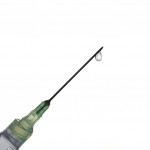
Elimination of bacteria from the root canal is a key aim of root canal treatment (RoCT). The aim of this study was to compare the results of a non-activated single-irrigation protocol (NAI) that used only 1% Sodium hypochlorite (NaOCl) with a passive ultrasonic multi-irrigation protocol (PUI) that used 1% NaOCl, 17% ethylenediaminetetraacetic acid (EDTA), and 2% chlorhexidine (CHX).
Patients requiring primary RoCT of a posterior tooth with apical periodontitis, which was verified with a radiograph and negative cold test, were eligible for inclusion. Standard nonsurgical endodontic therapy was performed on both groups in a 2-visit approach by using calcium hydroxide intracanal medicament with patients randomised to either the PUI or NAI protocols. The primary outcome was bacterial cultures taken at 4 time periods, before instrumentation, after irrigation protocol, after CaOH2 medication, and before obturation.
- 50 teeth in 49 patients were included, 4 patients did not return for 2nd visit obturation.
- There was no statistical difference between the two groups
- 21 of 25 teeth (84%) in the PUI group and 20 of 25 teeth (80%) in the NAI group had a negative bacterial culture after the initial irrigation protocols were completed.
- After intracanal medication with calcium hydroxide 40 of 46 remaining teeth (87%) had a negative bacterial culture. This number increased to 91% after the second instrumentation and irrigation was completed.
The authors concluded
There was no statistical difference between irrigation methods. Each protocol resulted in a high frequency of negative cultures. This high frequency of negative cultures obtained in 1 visit is most likely related to an increased volume and depth of irrigation compared with previously reported protocols.
Comment
This trail compares an irrigation protocol involving 3 key agents (NaOCL, EDTA and CHX) ) with a single agent NaOCL and finds no statistical difference in negative bacterial cultures. The study provides a great deal of detail regarding the clinical procedures employed, although no power calculation was presented to assess whether the sample size was large enough to detect a difference.
In a recent blog (Dental Elf 13th Sept 2012) we highlighted the Cochrane review by Fedorowicz et al that compared different endodontic irrigation protocols. In a article by Basrani from the JCDA Express looks at 3 articles that examines three reviews of passive ultrasonic irrigation in endodontics.
Links
Beus C, Safavi K, Stratton J, Kaufman B. Comparison of the effect of two endodontic irrigation protocols on the elimination of bacteria from root canal system: a prospective, randomized clinical trial. J Endod. 2012 Nov;38(11):1479-83. doi: 10.1016/j.joen.2012.07.005. Epub 2012 Sep 5. PubMed PMID: 23063221.
Basrani B – Is ultrasonic irrigation needed in Endodontics?
